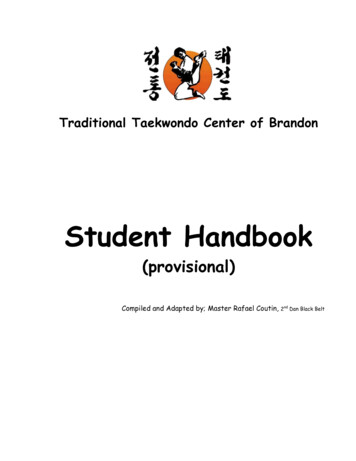
Transcription
Traditional Taekwondo Center of BrandonStudent Handbook(provisional)Compiled and Adapted by; Master Rafael Coutin, 2nd Dan Black Belt
Commit your spirit to the pursuit of excellence.- ‐Grandmaster Gerhard Brunner
ContentI - IntroductionII - About TaekwondoIII - About the Traditional Taekwondo CentersIV- Dojang RulesV - Philosophy: Creed, Tenets and Oath of Taekwondo StudentVI - The Taekwondo Belt SystemVII - How to tie your beltVIII - The FlagsIX - Korean terminology and English equivalentX – Taekwondo PracticeAppendix A: The Traditional Taekwondo Forms.Appendix B: Curricular breaking combinations per Kup.Appendix C: Curricular self-defense techniques per Kup.
I. Introduction.Welcome to the Traditional Taekwondo Center of Brandon!The purpose of this manual is to help you with training and understanding of theart, however, this document is provisional, and a more complete handbook is underredaction, so this material contains only a few things that may be useful as youbegin your study of Taekwondo. If you would like to read more about this art andits origins, please feel free to ask senior students and instructors when you havequestions.In this document will appear some key terms in Korean and the approximatedtransliteralization to English.The original Hangul (Korean Writing) has beenprovided wherever available, so student may try to few tools in the Internet thatproduces sounds from foreign writing (e.g. GOOGLE).Even though there are few graphics in this manual wherever was possible anduseful to have it, the absence of pictures or graphics displaying techniques isintentional, first because there are out of the scope of this documents, andseconds because we don’t want anybody trying to learn something that have notpreviously learned in class.IMPORTANT: The techniques and procedures described here are meant asreference only. They should be learned and practiced under the guidance of acertified instructor only.
II.About TaekwondoTaekwondo is a Korean unarmed martial art. Literarily TAE KWON DO means TheWay of the Foot and the Fist. Taekwondo is relatively young Martial Arts, Koreanmaster who returned to their homeland after WWII ended formed it as a resultof blending few Chinese and Japanese Martial Arts. By that time the then formingKorean Army included the 29th Infantry Division under the leadership of Gen. Choi,Hong Hi who impulse the learning of Martial Arts in his unit. So Taekwondo wasoriginal born as a hand-to-hand war fighting method.Nowadays, many people practice Tae Kwon-Do for its self-defense benefits, but itis also an art and is studied and appreciated for its beauty and grace of movement.The spiritual aspect of Tae Kwon-Do is found in its philosophy of self-restraint,kindness and humility.Traditional Tae Kwon-Do is the original style which differs from modernized formsand other martial arts in several ways: no physical contact is allowed in freesparring, it is more aerobic in training than other styles, and the emphasis is oneach student’s own improvement rather than on competition with others.It is not only kicking and punching, but also a way of thinking and living. The goal ofTaekwondo is to achieve total mind and body development through training. Beyondthe self-defense benefits, it is studied and appreciated for its beauty and graceof movement. The spiritual aspect of Tae Kwon-Do is found in its philosophy ofself-restraint, kindness and humility.
III. About the Traditional Taekwondo CentersThe Traditional Taekwondo Centers were founded by Kwan Jang-Nim GerhardBrunner, who has been practicing Tae-Kwon-Do for 37 years. He holds a 7th Danblack belt and has been teaching for over 30 years. Master Brunner has gainedinternational recognition and numerous awards throughout the years, including theHall of Fame Award for Outstanding Traditional Leadership. After establishingnine schools in Germany he opened the first Traditional Tae-Kwon-Do Center inTampa, Florida in 1997. Currently there are four centers in the Tampa Bay Area,one of them in Brandon, which opened on May 2010.
Lineage of the Traditional Taekwondo Centers:
Dojang RulesDo-Jang (도장) is the Taekwondo School. Composed of two words; Do Path andJang Hall or room. Which approximately means the hall of the path. Is the placewhere you will find your path in Martial Arts.There are some courtesy and general conduct rules and rules to follow in aTraditional Taekwondo Do-Jang: Attend classes regularly for your own benefit. Be on time for class schedule.Punctuality is the first form of respect; educating yourself being punctualwill be an asset in your professional life. Bow on entering and leaving the Do-Jang, when starting and ending of a classas well as before any partner exercise. Students must bow to the blackbelts and instructors when entering and leaving the Do-Jang. Don't stare atyour bowing partner in the eye while bowing, this is considered disrespectful.Bow is an act of trustfulness and also of respect. Bind your belt before entering the Do-Jang. Use the correct knot. Neatnessis a good habit to be used to, and also a rule. Don't wear shoes, watches or jewelry in the Do-Jang. Jewelry can hurtyourself or your partners; it is also disrupting the uniformity and the senseof equality among the practitioners. Pay attention to personal hygiene. Especially shorten your toe andfingernails. Avoid hurting or bothering, yourself or others by not taking careof your personal hygiene. Wear a white and clean Dobok, with the system patches and lettering. Donot wear an undershirt (except women). Your Dobok absorb your sweatduring the workout; so do not keep it unclean between classes.
Refers to senior students, instructors and higher rank bearer in a courteousmanner, using their rank, if you don't know it, use the words "Sir" or"Ma'am" when speaking to them. Do not open or close doors without permission of your instructor or schoolstaff. Absolutely no talking neither loud laughing during class, including whileseating. Making noises in class is not only disrespectful, but also interferesthe normal course of the class. Keep quiet during sitting down. Sit down tall on the floor; do not lean on thewall. This is not only made you looks great, but made your body stronger andimproves your focus. Do not leave the mat during class without permission of the instructor. It isan act of discourtesy to turn your back to your instructor and leave the mat. Do not interrupt the class asking questions to your instructor, if you have adoubt, keep it until the class finished and then ask your instructor or ahigher belt student. Do not use any electronic devices while a class is on course. Do not practice free sparring without permission and/or without asupervising instructor. Do not cross the lines when moving through the mat. Keep the Do-Jang clean. Do not eat or drink inside the Do-Jang. Pay attention to the directions and orders of your teacher. Respect your instructor and fellow students. Be courteous and helpful. Respect and honor your parents and other relatives. Students must respect and honor their instructor. Respect and honor your country.
Philosophy: Creed, Tenets and Oath of Taekwondo StudentThe upsurge in aggressive behavior in today’s society, has led to a loss of thebasic moral values that many people once shared. Many people are misguided,left to search for their own values in a disillusioned society where of war, crimeand corruption is common. The founders of Taekwondo believed through thephilosophy of this art that we could make the world a better place.The philosophy of Taekwondo is summarized in the tenets and the oath.Additionally our Traditional Taekwondo promotes the Student Creed, which is acode of conduct for all our students.a. Student Creed: I will develop myself in a positive manner and avoid anything that wouldreduce my mental growth or my physical health. I will develop self-discipline in order to bring out the best in myself andothers. I will use what I learn in class constructively and defensively, to helpmyself and my fellow man, and never be abusive or offensive.b. Tenets of Taekwondo:1. Courtesy (Ye Ui / 예의): Showing courtesy to all, respecting others,having manners as well as maintaining the appropriate etiquette at alltimes, both within and outside the Dojang.2. Integrity (Yeom Chi / 염치): Although it may be similar, this form ofintegrity takes on a wider role then defined in the common dictionary.In Taekwondo, integrity means not only to determine what is right orwrong but also having the conscience to feel guilt if one has donewrong and to have the integrity stand up for what is right.
Original Hanja Calligraphy of the five tenets by Gen. Choi, Hong-hic. Perseverance (In Nae / 인내): One will persevere time and time againuntil they have achieved a result, which is adequate towards what onewas trying to achieve.d. Self-discipline (Geuk Gi / 극기): This means to not only have controlover one's physical acts, but also their mental thoughts and actions.e. Indomitable spirit (Baekjeol Bulgul / 백절불굴): To have indomitablespirit means to have the courage to stand up for what you believe in, nomatter what odds you are up against, and to always give 100% effort inwhatever you do.3. Taekwondo Student Oath:a. I shall observe the tenets of Taekwondo. All students must carefullyobserve, acknowledge and live by each one of the Taekwondo tenets.b. I shall respect the instructor and seniors. A student vows to respecttheir instructors and those senior to them (both in age and rank). An
instructor must also act respectfully to all students and persons inorder to be respected.c. I shall never misuse Taekwondo. One will never misuse Taekwondo toharm other, for his own personal gain or for any other manner that isunjust.d. I shall be a champion of freedom and justice. This can apply to manyareas of life and although many may think one would have to dosomething amazing to achieve this; even the littlest things in ones dailyactivity can respect this part of the oath. If one becomes more openminded to understanding others ideologies or the way others go abouttheir lives instead of being quick to judge, then maybe the world wouldbe a more understanding and accepting place.e. I shall build a more peaceful world. One can also easily obtain this goalby going about their daily lives in a more peaceful manner. If everyonedid this, the world would obviously become a more peaceful place.
IV. The Taekwondo Belt SystemThere are six colors of belts: white, yellow, green, blue, red, and black. The widthof the belt is 5 centimeters and the thickness is 5 millimeters. The colors have notbeen arbitrarily chosen. They are steeped in tradition. The colors of black, red,and blue denoted the various levels of hierarchy during the Koguryo and SillaDynasties.The meaning of the belt colors are as follows:White: Signifies a birth, or beginning, like a seed.Yellow: Signifies the first beam of sunlight, which shines upon the seed giving itnew strength with the beginning of new life.Green: Signifies the growth of the seed as it sprouts from the earth reachingtowards the sun and begin to grow in a plant.Blue: Signifies the sky, as the plant continues growing toward it.Red: Signifies the red-hot heat of the sun as the plant continues growing towardit.Black: Signifies the darkness beyond the sun. Ready to plant new seeds, a neverending process of self-growth, knowledge, and enlightenment.
V.How to tie your beltHold belt at its center, ends even, with stripes (if youhave them) on the left side.Place center of belt on front center of jacket, aboutone inch below the naval (a location called thetandem). Wrap belt around your waist, crossing theright side over the left side at center of the back.Stripes will now be on your right side. Pull ends of beltforward and adjust so the ends are even.Lay the left side of belt over the tandem. Lay theright side of belt across the tandem. Stripes will nowbe on your left side.Slide the left side of belt (striped side) under andbehind all the belt layers at the tandem. Stripes willstill be on your left side.Loop
Bring left (striped) end of belt down and over thefront of the ULoop striped end under and up through the U shape toform a knot.Pull ends of belt outward to tighten knot. Stripes willbe on your right side.Adjust knot so the ends of belt are even and hangneatly.
VI. The FlagsWe hang the flags in the Dojang out of respect for the country where Taekwondooriginated and to show respect to the country that we live in. The flags are hung sothat when we stand between the flags facing the class, the U.S. flag is on ourright, and the Korean is on our left. Pursuant to U.S. flag code, the U.S. flag shouldbe hung in a position of superiority (higher and/or to the right) whenever it isdisplayed. To hang the flags in the vertical position, the Korean flag is simplyturned 90 o clockwise. The U.S. flag is hung so that the stars remain in the upperleft hand corner.Korean FlagAmerican Flag
VII. Korean terminology and English equivalentNotice: Modern Korean Language uses the Hangul scripts an alphabet of 24 vowels and consonants.Therefore, there is not a 100% match in the transcript to English of many phonemes, for instancethe consonant T and D may sound similar, also happens with K and G and P and B.General Terms:Kwanjang-NimSahbum-NimSystem GrandmasterGrand Master (5 Dan and HyungTyKihap!TallyonHabokbuKamsahamnida!Master (1-3 Dan)Advanced student (Assistant ttle cry (ki energy, hap concentration)ExerciseCenter of gravity, energetic center"Thanks!"Directions:Naeryodown, downAnuroinwardly guided movement ("An" "inside")Pakkurooutward guided movement ("Pakkat" "outside")Ollyoup (swinging)Chukkyoupward (lifting) / e.g. Upward Block Dan-Gun HyungNullodown (punchy)Apdirected forwardDwitbackwardAp-balfront legDwit balrear legChongulstraight body, frontally directed, facing forwardYopsideways, performed on the body side
Sewovertical, uprightTyjiborotated by 180 (tyjibo-kwon-Chirugi in Kwan-Gae Hyung)Tollyocircularly rotatedBandalCrescent-shaped (eg Bandal-Sun Magki, Bandal-Chagi)TimyojumpingYokreverse, vice versa (eg Yok Sudo)Torahperformed with body rotation around the longitudinal axisHa danLower level, lower bodyChung danMedium level, hullSang-danUpper level, head heightOrunrightOenleftSsangleft and right simultaneously, a double movementTutwice, in the same direction (Tu-palmok-Magki)Baroequilateral, straightPandaescalene, mutuallyKumgang"Mountain", up and down simultaneouslyGutjain the form of a nine, eg nine block in Gae-Baek HyungMongdungiU-shaped one above the other (eg mongdungi magki as thelast movement in Choong Gun Hyung)also: digut (the Korean characters digut looks like a U, asDigut Chirugi, twin sliding over each other)Commands:RomanizationGukki Taejo-eToraCharyeotGyong-nye! 경례BaroSwieoKihapHangulMeaning국키 태조에 Turn to the flag!토라Turn!차렷Attention positionSincerely, Bow!바로Return to initial position쉬어At ease, relax기합Yell
an그만Dwiro tora 뒤로 돌아Haesan해산Shi-O쉬어Ready positionBegin, startBreak (separate)ContinueFinish (stop)Turn around (about turn)DismissStand at ease!Counting in tilgopyeodeolahopyeolyeolhanayeoldulseumulseumul ally, we don't do sets of exercises larger than ten, unless we're doing themfor a set length of time.Ordinal Numbers: irdFourthFifthSixthSeventhEighthNinthTenth
Basic stances: SogiAlthough there are strong similarities in stances throughout Taekwondo schools,individual instructors often have their own preferred style. For example, in theMoa stance, feet are often at along of each other, keeping eyes forward whilebowing. However, many instructors prefer the feet parallel forward, with the eyesfacing toward the floor while bowing (as a sign of respect and trust for thosearound them).DiagramNameDescriptionMoa Sogi This is the attention position used before and(Attention after class.Position) The feet are parallel and side by side Whenbowing you bend 40o forward, keeping your eyesaverted from your opponent, as looking straighton denotes disrespect.NaranhiSogi(ReadyPosition)Ready Stance refers to the most common readyposition use Taekwondo training. Ready Stanceis performed by standing with the feet oneshoulder length apart, measured from theoutside edge (Foot Sword) of the feet, witharms slightly bent and loosely held fists aboutone fist size apart just below the navel and thefists should be a fist size away from the body.Muscles are relaxed to promote movementspeed from this position. This stance and itsvariants are most often used at the start offorms. The student should be alert and aware,inhale and breathe out 1/3 of the air in yourlungs.
ChongulSogi(ForwardStance orFrontStance)Front stance is used when mobility is important.Body should be relaxed. From the attentionstance with feet together, one foot is placedstraight ahead of the other, about a normalwalking step.The distance between both heels is about ashoulder length to one-half shoulder length.Rear toes are turned outward about 30o. Theweight should be 50-50.HoogulSogi(L Stanceor BackStance)This stance is specifically focused on shiftingweight to the back leg, as it offers much morecontrol, and makes it easier to kick off thefront leg. To perform this stance, the bodyfaces to the side, with the front foot facingforwards, front leg bent. The back leg is bentslightly, and the foot is turned outwardsperpendicular to the front foot. Align your feetas stated above and make sure your body isturned so only your front shoulder is visiblethrough the mirror. Since there is virtually noweight on that front leg, it can be sweptwithout affecting the practitioner's overallbalance. The weight distribution of this stanceis 30%-70%. Both legs should be slightly bent,the back foot or the foot with the most weighton it should be bent in slightly. The back kneeshould be over the foot.Dwit BalBoth feet shoulder width apart, the front leg ispropped up only on the toes and faces forward.Sogi (hindThe rear leg shows 90 to the side and carriesleg stance) the body weight.
Tora DwitBal Sogi(twistedhind legstand)As Dwit BAL SOGI, the front leg on the ball ofthe foot is screwed to the inside. The frontknee is pointing thus to the rear. With fronthand in the Sudo position is the startingposition for combination techniques.Kima Sogi(horseridingstance)The horseman stance is generally used topractice punches. It is similar to the readystance. Feet are placed much wider, about twoshoulder length apart. Also, the knees aredeeply bent. The shins should be keptperpendicular to the floor. This requires theknees to move outwards away from the body.The hands are held in fists, on the hips at beltlevel, with the thumbs up. When a punch isthrown, the hand rotates 180o to turn knucklesup before making contact. The objective istypically to keep the back straight whilelowering the buttocks down to the ground withthe legs spread keeping shins perpendicular tothe floor. The ultimate goal is to maintain thisposture while the tips of the belt touch theground.KojongSogi("solidstate"wide Lposition)("solid state" wide L-stance) As hoogul sogi, butthe weight is distributed evenly on both legsand the overall position is deeper and longerthan hoogul. (Eg: third movement of the WonHyo Hyung)KyochaSogi(crossoverposition)(cross-over stance) Both legs are crossed; theback leg is supported with the knees, the kneeof the front leg.
SasonSogi(diagonalposition)Diagonal position. Foot position as Kima Sogi,the feet are however, offset by a foot width inthe viewing direction. (e.g. in the twenty-fourthmovement of the Sam-Il Hyung or in themovement seventeenth of the Se-Jong Hyung)KoryjugiSogi(fightingstance)Fighting stance. The name of the fight-groundstance, not a separate position. Technically, aHoogul Pakkat Taebi Magki, ie an outward blockprotection in the forward step.GoburjoSogi(flexed)Flexed posture ("bending stance"), one leg,cooking a kick (seventh mov. Won-Hyo)Mureup Kneeling. Like Choongul Sogi, with the knee ofSogi (knee the rear leg touches the ground. The foot oflevel)the rear leg stands on the toes. (eg, ChoongJang Hyung)
Hand Techniques:Taekwondo hand strikes are performed at a closer distance than kick techniques.They are executed in a number of ways - from standing, jumping, spinning andrushing forwards. Hand strikes make up fast combinations of strikes which canleave an opponent stunned and unable to continue attacking. Taekwondo handstrikes can be separated into two distinct styles:- Closed hand strikes (Punches):- Open hand techniques (Knifehand, Ridgehand and spearfingers)Various surfaces of the hand may be engaged as the striking surface depending onwhich area of the opponent’s body which is being targeted. This leads to a largearray of hand positions.Korean Terms for Hand Techniques:SudoHand edge, common use: Knife handYok sudoLiterally: "inverted" hand edge, common use: ridge hand.KwonFistSoo (son)Hand (eg. Pandal son; right hand)Ri-kwonBack fist (Dung Back)Yu-KwonClench Fist (Yukwon Taerigi, e.g. in the Hwa-rang Hyung)Jang-kwonPalm of the handPen-kwonLiterally: Long fist (knuckles of the second phalanges)Chong-kwonStraight, front fistGwan-suFingertipsGawi-son"Scissors hand", such as sticking with two fingersAgum-sonFinger tongs, Chung Jang-hyungSon-BadakPalmPalArmPal-kupElbowPal mokForearmMap PalmokThe inside of the forearmPakkat PalmokThe outside of the forearm
Hand Strike Techniques:Forefist (Chirugi): A closed fist may be jabbed out directly to strike with theforefist knuckles. This is a suitable position for general punches to soft areas ofthe body. Without protection, it is inadvisable to strike the bony face as fingersare likely to get broken on the hard temple and jaw bones (a.k.a. jumok).Hammer fist (Yup Ju Chirugi): A closed fist may be brought down in a hammeringmotion to strike with the underneath. Such a strike can obliterate an opponent'snose, making it near impossible for him to retaliate.Backfist (Ri-kwon Chirugi): A clenched hand is swung backwards into the face of anopponent. The back of the hand makes contact and the momentum garnered in theswing makes this a powerful strike (a.k.a. Son Dung Chirugi.)Knife Hand (Sudo): Is where an open hand is hammered down to make impact withthe underside. This are commonly made to soft parts of the body like the side andfront of the neck (a.k.a. sonnal).Ridge Hand (Yok sudo): Is where an open hand is hammered down (the opposite ofknife hand) and the top of the open hand strikes. This are commonly made to softparts of the body like the side and front of the neck.Fingertips (Gwan-su): can be used to strike vulnerable areas of the body such aspressure points. Used in self-defense and not competition sparring, one and twofinger strikes are made to the eyeballs. Four finger strikes engaging the tips ofthe outstretched hand (known as Spear hand) can be made to vital points in theneck (a.k.a. Joomuk).Thumb (Umji): is a fist with the thumb protruding over the top. This is aformidable weapon in pressure point striking. Vulnerable areas can be targeted all
over the body such as the sternum, the spaces in between the ribs and other nerveclusters.Palm Heel (Son-Badak): Is a classic self-defense strike where the hand is pulledback to engage the base of the palm in an upwards thrusting strike.Elbow Strike (Palkkumchi): Forearm is folded inwards towards the body and thestrike is delivered with the outside of the forearm or elbow.Long fist strike (Pen-kwon): Instead of closing the fist completely, the fingers areheld out and only the knuckles are bent thereby presenting the upper set ofknuckles as the striking surface. This fist is used for breaking boards as thesmaller surface area concentrates the punches power. Tae Kwon Do also makes useof reverse and front elbow strikes.Kick Techniques (차기 Chagi): Is a strike technique using the foot, leg, or knee.All kicks can be executed as jump kicks, spin kicks, jump spin kicks or multirotational spin kicks. Also the front or rear leg in a given stance can perform allthe above.Korean Terms for Kick TechniquesDariLegBalFoot, also ChokkiMureupKneeApchukBall of footDwit-chukHeel ballDwit-kumchiHeel rearChokdoFoot bladeYok ChokdoInner edge of footBal-tungFoot instep (e.g. Baltung-chagi)Cha'olligiFoot swing with stretched leg
Cha'tulkiNeedle movement with the ball of the foot (e.g. Yop cha tulki)GoroSweeping (e.g. Goro ch agi, leg sweeping technique)Miroslide (e.g. Miro ap ch agi, push pedal forward)Some of the best-known Taekwondo kicks include:Front Kick (Ap Chagi): This is a very linear kick. The practitioner raises the kneeto the waist, pulls the toes back and quickly extends the foot at the target hittingwith the ball of the foot (Apchuk).Back Kick (Dwit Chagi) the opposite of the front kick. The performer raises theknee to the waist pull the toes back and swing the leg backward extending it andhitting the target in the back with the heel ball. Practically, it is a quick defense toan approaching opponent from the back.Side Kick (Yeop Chagi): A very powerful kick, first the practitioner simultaneouslyraises the knee and rotates the body 90o, and then quickly extends the leg,striking with the blade of the foot (Chokdo).Reverse Side Kick (Tora Yeop Chagi): Here the body turns further, allowing theheel to hit the target with the foot pointing to the side as in a regular side kick,instead of more downward as in a true back kick.Roundhouse Kick (Tollyeo Chagi): The practitioner raises the knee, turns the hips,pivots on the non-kicking foot, and snaps the kick horizontally into the target at a80o to 90o angle, either with the instep or with the ball of the foot (in the lattercase, with the toes pulled back out of the way as in a front kick). The lattertechnique requires a great deal of flexibility in the heel.Upward Roundhouse Kick (Ap-Tollyo Chagi): This is a speddy kick very common insparring matches, quite similar to roundhouse kick, but this starts with an angle ofta 30 respect to the body (a.k.a.: Baltung Chagi ).
Reverse Roundhouse kick (Pandae Tollyeo Chagi): Here the practitioner turns thebody away from the target and pushes the back leg straight toward the target,hitting it with the heel while watching over the shoulder. The turning motion helpsto give this kick a lot of power. Without proper care, you can "spin out" and loseyour balance from using this attack.Heel Kick (Pandae Chagi a.k.a. Goro Chagi): Leg extended to the front very similarto the roundhouse kick, but instead of hitting the same side the foot dodge to theopposite side, then is pulled in the opposite direction hitting with the heel (e.g.Sam Il-Hyung).Hook Kick (Golchyo chagi): A less popular kick traditionally, it has found increasingfavor in modern competitions. It works very similar to the heel kick, however thefoot snaps it around in a dorsal arc, with the heel pulling it backward like hook (eg18th Hyung).Axe Kick (Naeryeo Chagi): Another kick that has increased in popularity due tosparring competitions. The leg is raised in front of the body. The leg remainsstraight or close to straight as it rises, then the leg is pulled down with the heelpointed downward. It is typically targeted toward the head or shoulders andrequires significant flexibility to employ effectively. This kick is best used againstthe collar bone, which can readily break from this attack.Variations: Anuro Naeryo chagi: kick is pulled from the outside in, then down Pakkuro Naeryo chagi kick is pulled from the inside out, then downInner Crescent Kick (Sewo Chagi): The motions are the same but the direction ofthe kick changes, this time originating from the outside of the body, headingtowards the inside, or centerline of the body.
Variations:Sewo An Chagi:Circular. Foot turns inward (foot vertical, foot blade hits)Sewo Pakkat Chagi: Circular. Foot turns outward (foot vertical, inner side of the foothits)Semicircular Vertical Kick (Bandal Chagi): Often (wrongfully) called also NaeryoChagi. Is taken with the foot sword (e.g. at end of Kodang Hyung). The kick is like aSewo Chagi, who will be deposed at the highest point vertically down. Themovement is thus only a semicircle in contrast to full circular run of the SewoChagi technique.Spinning Heel Kicks (Dweel Chagi): There are several spinning kicks that involvethe rotation of the entire body and head before the kick is released. Spinningkicks includes the Reverse Roundhouse kick, Reverse Side Kick (discussed above),Spinning Hook Kick (Dweel Golchyo Chagi), spinning axe kick, butterfly kick and anumber of other kicks of varying popularity.Twist Kick (Pituro Chagi): Contrary to the roundhouse kick, this is an inverseoutward kick that goes from the inner-lower section of the body to the outer-highsection. Twisting the leg from the hip to the foot. The kick requires a greatstretching and good training.Knee strike (Mureup Chagi): This technique is useful for a close distant fight. Isperformed rising the knee upward to strike the body or even the head of theopponent, very often while grabbing the target with both hands.Jumping Kicks (Twimyo Chagi):There are also many kicks that involve jumping before their execution. Theseinclude jumping front kick, jumping side kick, jumping axe kick, jumping roundhouse,
jumping spinning hook kick, jumping spinning roundhouse kick, butterfly kick,jumping back kick, and jump spinning side kick. Normally, jumping kicks involvepulling up the back leg to help gain height during the jump and then performing thekick itself with the front leg.Advanced Kicks: There are a variety of kicks that can be used in combination orste
II. About Taekwondo Taekwondo is a Korean unarmed martial art. Literarily TAE KWON DO means The Way of the Foot and the Fist. Taekwondo is relatively young Martial Arts, Korean master who returned to their homeland after WWII ended formed it as a result of blending few Chinese










